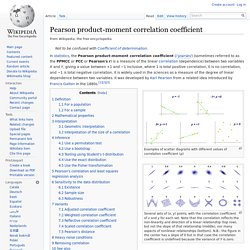

Job at Expo. Pearson product-moment correlation coefficient. In statistics, the Pearson product-moment correlation coefficient (/ˈpɪərsɨn/) (sometimes referred to as the PPMCC or PCC or Pearson's r) is a measure of the linear correlation (dependence) between two variables X and Y, giving a value between +1 and −1 inclusive, where 1 is total positive correlation, 0 is no correlation, and −1 is total negative correlation.

It is widely used in the sciences as a measure of the degree of linear dependence between two variables. It was developed by Karl Pearson from a related idea introduced by Francis Galton in the 1880s.[1][2][3] Examples of scatter diagrams with different values of correlation coefficient (ρ) Several sets of (x, y) points, with the correlation coefficient of x and y for each set.
Balance Automator 2011. LabAutomation2011. Service Manager. Balance Automator 2011. Pearltrees videos.